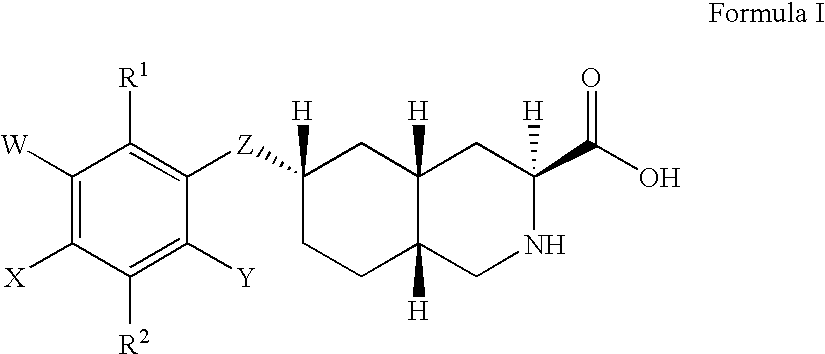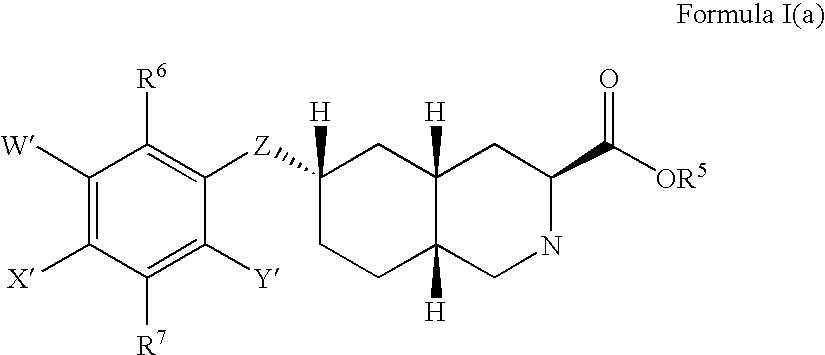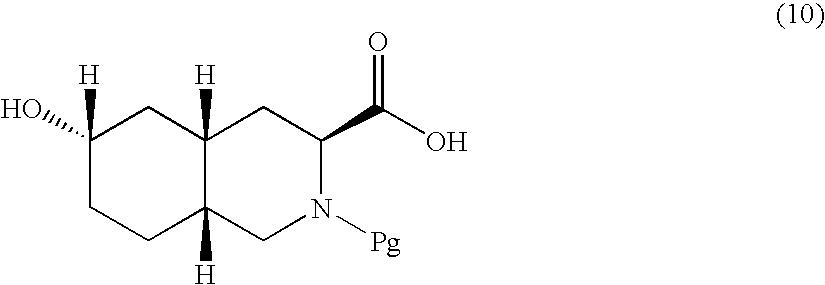Excitatory amino acid receptor antagonists
- Summary
- Abstract
- Description
- Claims
- Application Information
AI Technical Summary
Benefits of technology
Problems solved by technology
Method used
Image
Examples
preparation 1
Ethyl (3S, 4aR, 6R, 8aR) 6-hydroxy-2-tert-butoxycarbonyl-1,2,3,4,4a,5,6,7,8,8a-decahydroisoquinoline-3-carboxylate
[0173]
A. Ethyl (3S, 4aR, 6R, 8aR) 6-hydroxy-2-tert-butoxycarbonyl-1,2,3,4,4a,5,6,7,8,8a-decahydroisoquinoline-3-carboxylate
[0174] To a −78° C. solution of (3S, 4aR, 8aR) 6-oxo-2-tert-butoxycarbonyl-1,2,3,4,4a,5,6,7,8,8a-decahydroisoquinoline-3-carboxylic acid (6.88 g, 21.14 mmol)(see Preparation 2, Steps A and B, below and Scheme III, Step A generally) and cerium trichloride heptahydrate (7.9 g, 21.2 mmol) in absolute ethyl alcohol (90 mL), under nitrogen sodium borohydride (1.24 g, 32.73 mmol) was added in portions. The resulting mixture was slowly warmed up to room temperature over 5 hours. The reaction mixture was cooled down to 0° C. and acetic acid (50% in water, 25 mL) was carefully added. The resulting mixture was stirred for 1 hour at room temperature and the solvent was removed in vacuo. To the resulting material water and ethyl acetate were added and the phas...
example 1
Preparation of (3S, 4aR, 6S, 8aR) 6-(3-Carboxy-naphthalen-2-yloxy)-1,2,3,4,4a,5,6,7,8,8a-decahydroisoquinoline-3-carboxylic acid hydrochloride
[0175]
A. Preparation of ethyl (3S, 4aR, 6S, 8aR) 6-(3-ethoxycarbonyl-naphthalen-2-yloxy)-2-tert-butoxycarbonyl-1,2,3,4,4a,5,6,7,8,8a-decahydroisoquinoline-3-carboxylate
[0176] A solution of the material from preparation 1 (120 mg, 0.37 mmol), triphenylphosphine (145 mg, 0.55 mmol), ethyl 3-hydroxy-naphthalen-2-carboxylate (111 mg, 0.55 mmol) in tetrahydrofuran (1.9 ml), was treated with diethylazodicarboxylate (0.090 mL, 0.55 mmol) at room temperature for 16 h. Flash chromatography (silicagel, 50% diethyl ether / hexane) gave 103 mg of the title intermediate (55%).
B. Preparation of (3S, 4aR, 6S, 8aR) 6-(3-Carboxy-naphthalen-2-yloxy)-1,2,3,4,4a,5,6,7,8,8a-decahydroisoquinoline-3-carboxylic acid hydrochloride
[0177] To a solution of the material from step A (103 mg, 0.20 mmol) in tetrahydrofuran (0.5 mL) hydrochloric acid (3N, 1 mL) was added. T...
example 2
Preparation of (3S, 4aR, 6S, 8aR) 6-(4-carboxy-biphenyl-3-yloxy)-1,2,3,4,4a,5,6,7,8,8a-decahydroisoquinoline-3-carboxylic acid hydrochloride
[0180]
A. Preparation of ethyl (3S, 4aR, 6S, 8aR) 6-(4-ethoxycarbonyl-biphenyl-3-yloxy)-2-tert-butoxycarbonyl-1,2,3,4,4a,5,6,7,8,8a-decahydroisoquinoline-3-carboxylate
[0181] Following the procedures as described in Example 1, step A, a solution of the material from preparation 1 (2.02 g, 8.3 mmol), triphenylphosphine (3.15 g, 12.0 mmol), ethyl 3-hydroxy-biphenyl-4-carboxylate (2.63 g, 8.02 mmol) in tetrahydrofuran (42 mL), was treated with diethylazodicarboxylate (1.89 mL, 12.0 mmol) at room temperature for 20 h. Flash chromatography (silicagel, 30% diethyl ether / hexane) gave 2.76 g of the title intermediate (62%).
[0182] Mass Spectrum (Fast Atom Bombardement) M+Na: 574.2
B. Preparation of (3S, 4aR, 6S, 8aR) 6-(4-carboxy-biphenyl-3-yloxy)-2-tert-butoxycarbonyl-1,2,3,4,4a,5,6,7,8,8a-decahydroisoquinoline-3-carboxylic acid
[0183] To a solution of...
PUM
| Property | Measurement | Unit |
|---|---|---|
| Volume | aaaaa | aaaaa |
| Volume | aaaaa | aaaaa |
| Volume | aaaaa | aaaaa |
Abstract
Description
Claims
Application Information
 Login to View More
Login to View More - R&D
- Intellectual Property
- Life Sciences
- Materials
- Tech Scout
- Unparalleled Data Quality
- Higher Quality Content
- 60% Fewer Hallucinations
Browse by: Latest US Patents, China's latest patents, Technical Efficacy Thesaurus, Application Domain, Technology Topic, Popular Technical Reports.
© 2025 PatSnap. All rights reserved.Legal|Privacy policy|Modern Slavery Act Transparency Statement|Sitemap|About US| Contact US: help@patsnap.com



